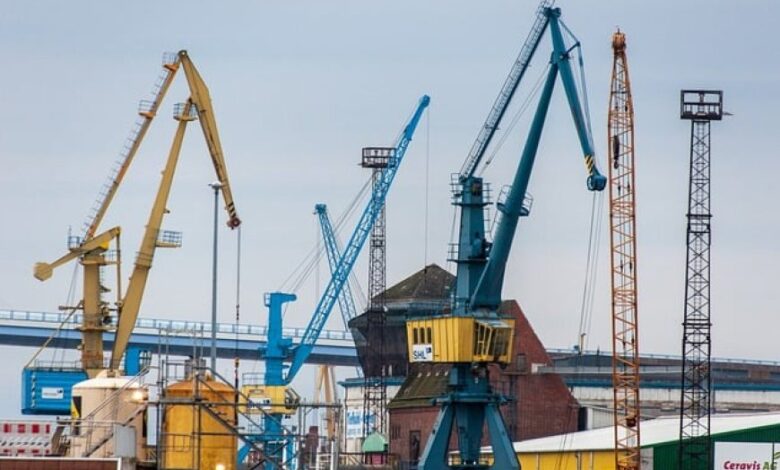Industrialisation in Africa: Leading countries and reasons for their success

Source: UNIDO, 2023.
An expanding number of African nations have tried to promote industrialisation and diversify their economies in recent years. Ethiopia, renowned for its burgeoning leather industry, and Ghana and Kenya, both situated in the pharmaceutical sector, have promising emerging industries. Several countries are developing networks of special economic zones (SEZs) and industrial parks (MEZs) as part of their efforts to foster the expansion of small and medium-sized enterprises (SMEs). These investments have yielded substantial returns. From 2010 to 2019, MVA in Ethiopia experienced a fourfold growth, reaching just below USD 5 billion (African Development Bank, 2022). Ethiopia’s textile and garment industry is experiencing rapid growth, with domestic and multinational firms producing textiles for domestic and global markets. The government launched Plan 2020 to generate USD 1 billion in export earnings and over 300,000 employment opportunities. Over the past six years, the textile and apparel industry expanded by an average of 51%, and foreign investors were granted licences for over 65 international textile investment projects. The textile industry’s expansion directly results from the government’s industrial development strategy (Alliance Experts, 2024).
In Rwanda, the government has set up technology hubs and incubators as part of a digitalisation strategy to boost economic growth and generate employment opportunities. With a projected GDP contribution of 3% in 2020, the ICT sector has made a substantial contribution to Rwanda’s economy. Thousands of people are employed throughout the supply chain, as well as in additional indirect jobs. Within ten years, the government hopes to triple the sector’s contribution to at least 10%. A thriving startup ecosystem has also been created in Rwanda due to the country’s growing entrepreneurial culture, which has encouraged many young people to launch their own ICT companies. The workforce’s increased skill, especially those with STEM degrees, has also helped transform the economy. In addition to promoting regional integration, Rwanda’s membership in the East African Community (EAC) has opened up new prospects for the ICT industry.
Ghana’s automotive industry is another nascent sector with great transformation and job creation potential. An estimated 100,000 vehicles are imported annually by the country, of which 90% are pre-owned or used (second-hand). To reduce reliance on pre-owned vehicles, in 2019 the government passed the Ghana Automotive Development Policy to attract investments from renowned Original Equipment Manufacturers (OEMs) to establish a fully integrated and competitive industrial hub for automotive assembly. Since then, over 11 OEMS have set up assembly plants in the country for the local market and sub-regional exports (The Business & Financial Times, 2023). These include Suzuki and Toyota (Toyota Tsusho Corporation), Volkswagen Group, Nissan (Nissan Motors Corporation) and Renault (Stallion Group). The entry of these OEMs bodes well for creating significant positive spillovers into local manufacturing and the metals sector in the medium to long term. However, these must be catalysed by deliberate policies to move from basic semi-knocked-down (SKDs) assembly to fully-built units (FBUs) where vehicles are largely manufactured, assembled and completed at an in-country production facility. The Ghanaian automobile market is anticipated to reach USD 2.07 billion by 2029 from USD 1.93 billion in 2024. Meanwhile, the government has devised a strategy to procure 1,000 electric buses for intercity (60%) and intracity (40%) transportation, in addition to charging and maintenance infrastructure. Ghana aspires to operate 12,027 electric public buses nationwide by 2050, accounting for 32% of the overall fleet.
Regional trends
Table 3 shows how the different economic regions compare on the various benchmarks. Overall, the COMESA, ECOWAS and SADC regions have the highest industrialisation indicators and, by extension, industrialisation potential.
ECOWAS
The Economic Community of West African States (ECOWAS) has revised its Industrial Agenda (WACIP) to focus on four industries: agro-industries, textiles and garments, pharmaceuticals, and automobile and automotive components. The primary focus on these industries stems from their potential to drive sustainable industrialisation, employment generation, economic competitiveness and regional integration. The revised WACIP demonstrates ECOWAS’ willingness to adapt and integrate lessons learned, highlighting the iterative nature of regional industrialisation processes. However, given the large number of unemployed youth, questions have been raised about the appropriateness of regional-level industrial policy (ECDPM, 2016).
SADC/COMESA
Due to the region’s capital and technology-intensive hydrocarbon and mineral production, as well as its lack of forward and backward linkages with the rest of the economy, employment growth has been constrained. Nevertheless, the region is experiencing notable enhancements in its generation capacity due to the anticipated launch of major power generation projects in Ethiopia, Kenya, Uganda and Zambia. Establishing the Zambia-Tanzania-Kenya and Ethiopia-Kenya interconnectors will enable the exchange of electricity between the southern and northern power grids. This is a potential enabler of rapid industrialisation. The Lobito Corridor, which connects the southern DRC and north-western Zambia to regional and global trade markets via the port of Lobito in Angola, is another potential industrialisation driver, especially for critical minerals value chains, including battery manufacturing (Acheampong, 2024).
IGAD
While Intergovernmental Authority on Development (IGAD) nations have experienced robust economic growth recently, detailed analysis shows that this growth has yet to result in significant structural transformation. Given the region’s 255 million inhabitants, of whom more than half are under 25 years old, unemployment is a significant issue. Primary commodities comprise the majority of IGAD member states’ exports and are susceptible to global price fluctuations. Due to the region’s weak manufacturing sector, it continues to grapple with substantial poverty and unemployment.
EAC
Industrialisation in the East African Community (EAC) is hampered by low electricity penetration, high costs, poor transport infrastructure, low human capital and protectionist policies.
What have been the reasons for African countries’ success in industrialisation?
Africa’s most industrialised nation, South Africa, has a varied economy and highly developed industrial sectors. Its strategic location at the southern tip of Africa, wealth of natural resources, infrastructure development, skilled labour force, strong financial system, political stability, economic diversification, regional leadership, and dedication to innovation and technology are important factors in its success. South Africa also has well-established vocational training programmes and education systems, while the nation’s robust financial system encourages entrepreneurship and makes investments in industrial projects easier. Furthermore, due to its advantageous geographical location, South Africa is able to access both domestic and global markets, which attracts foreign direct investment (FDI). Consequently, the nation contributes significantly to regional cooperation and economic integration.
The small Southern African nation of Eswatini has also made strides in certain industrial sectors (e.g. its robust textile and apparel industry), taking advantage of its strategic location, investment incentives, political stability, trade agreements, skills development, infrastructure development and diversification initiatives (World Bank, 2022). The government provides tax incentives, logistical backing and efficient regulatory systems to incentivise foreign direct investment. Political stability reduces the risks associated with conducting business in the nation and inspires investor confidence. Furthermore, Eswatini has undertaken infrastructure initiatives to foster economic diversification beyond conventional sectors such as agriculture. Industrial development policies have been enacted by the government, fostering an environment conducive to the flourishing of businesses and their contribution to the expansion of the economy.
Gabon has also achieved notable progress in industrialisation owing to its vast natural resource reserves, most notably timber, manganese and oil (Arise, n.d.). Foreign investment and employment opportunities are generated by the oil industry, which is a pillar of the Gabonese economy. To support industrial activities, the nation has invested in infrastructure projects encompassing energy infrastructure, transport networks and telecommunications. Additionally, in an effort to develop other sectors, including mining, forestry, agriculture and manufacturing, Gabon is implementing diversification strategies. Political stability has also played a role in the nation’s achievements. The government encourages foreign investment by providing tax breaks and customs exemptions, among other measures (U.S. Department of State, 2023). In addition to investing in education and skill-development initiatives, Gabon has a qualified labour force. The nation has also fostered strategic alliances with foreign governments and international organisations to further industrial development.
Algeria, situated in North Africa, has emerged as a significant participant in industrial development owing to its formidable oil and gas sector, ample natural resources and diversified economic foundation (World Bank, 2024). Investments have been made in infrastructure projects, including water supply systems, transportation, energy and telecommunications, to support industrial activities and economic expansion. A skilled, knowledgeable, educated labour force contributes to the country’s success. To encourage investment, the government provides a range of incentives, such as preferential treatment, tax breaks, subsidies and access to land and infrastructure (BMZ, 2024). Benefitting from political stability, Algeria has established trade relations with regional and international partners and takes advantage of a strategic location in North Africa that grants access to regional and global markets. In an effort to foster industrialisation, bolster domestic industries and increase competitiveness, the Algerian government has enacted industrial policies. Nonetheless, socioeconomic disparities, bureaucratic obstacles, regulatory restrictions and infrastructure deficiencies persist.
Egypt is a leading industrialised nation in Africa, with a robust manufacturing sector and a diverse industrial base (U.S. Department of State, 2023). Due to its advantageous geographical position at the intersection of Africa, the Middle East and Europe, the country attracts foreign investment and trade. Egypt’s expansive domestic market presents industrial producers with prospects to expand their production capacities. Infrastructure investment, encompassing energy and transportation, facilitates industrial operations and encourages investment. Diverse manufacturing substantially contributes to the gross domestic product and employment. Egypt has ratified multiple free trade agreements, which have promoted export-oriented industrialisation and facilitated trade integration. Its proficient labour force, governmental backing, technological advancements and innovation, tourism and services sector, political stability, and reform initiatives contribute to its success. Egypt’s ongoing endeavours to confront obstacles and exploit prospects have the potential to propel industrial expansion and economic progress even further.
What are the learnings for other African countries?
Policymakers should contemplate implementing structuralist industrial policies that prioritise the development of labour-intensive and knowledge-intensive sectors. Such policy directions are outlined below:
- Improved regional infrastructure, particularly transport, energy and communications, would attract increased investment in industry across the continent.
- Special Economic Zones with incentives and reliable energy and ICT infrastructure would also encourage private sector investment. However, public sector investments in infrastructure and human capital development are needed to attract private sector-led industrialisation.
- Despite recent sovereign debt issues in several African countries, there is still a significant demand for infrastructure and human capital development. Concessional financing for infrastructure is needed to reduce economic harm from rising debt burdens. Political coordination and the erosion of protectionist policies could attract more inward financing.
- Processing and beneficiation of mineral resources in-country, especially green minerals like nickel, lithium and cobalt. This will create green industrialisation opportunities for endowed countries, new avenues for green growth and sustainable job creation. Several African countries including Zimbabwe, Uganda, Tanzania, Namibia and Botswana, are considering this option to mitigate the energy deficit through green energy and industrialisation solutions, e.g. solar energy, e-batteries and wind energy turbines. This will further minimise GHG emissions, wean agriculture production from its weather dependency though green energy-powered irrigation innovations, expand the reach of electricity access, which is currently very low in Africa compared to other developing regions, and help to boost manufacturing value added to GDP.
By investing in education and infrastructure development, diversifying their economies, promoting good governance and political stability, encouraging innovation and entrepreneurship, fostering regional integration, and advancing sustainable development, the least industrialised African countries can gain insights from leading industrialised nations. The aforementioned insights may be implemented in African nations with the intention of formulating context-specific strategies that promote sustainable industrialisation and economic well-being. The least industrialised African nations can foster a culture of entrepreneurship, promote good governance, invest in education and infrastructure, diversify their economies and develop strategies that contribute to their economic growth and prosperity.
What role can Germany and the European Union (EU) play in this?
Germany and the EU can support African countries to industrialise faster through deepening the provision of funding and technical assistance. This can be done by helping to develop complementary technical and vocational skills training (TVET), as done so by the Deutsche Gesellschaft für Internationale Zusammenarbeit (GIZ); encouraging inbound FDI by European companies into renewables, component manufacturing and nascent industries such as green hydrogen; and supporting broader regulatory and business environment reforms. For example, through the GIZ the German Federal Ministry for Economic Cooperation and Development (BMZ) has been supporting the Ghana Skills Development Initiative which seeks to support the Ghanaian Government’s strategy to improve TVET systems to better meet the requirements for sustainable development (GIZ, 2023). One of the major areas of focus has been ensuring the availability of vocational schools offering training courses in the green sector. Such education and capacity building support initiatives can be expanded and rolled out to other countries on the continent to ensure that skilled mid-level manpower is developed with the capacity for industrial management, technology and innovation.
Additionally, the EU should expand its technical assistance provision to cover regional institutions involved in policymaking and regulatory frameworks that support industrial growth. In the context of increasing intra-African trade, such assistance can help African countries implement reforms that create favourable business environments via special economic zones, trade facilitation and proactive industrial policies.
As mentioned above, European companies should invest in African renewable energy and component manufacturing as well as nascent industries such as green hydrogen, as is already happening in Namibia. Meeting the 1.5°C target of the Paris Agreement calls for rapid decarbonisation, which means drastically reducing greenhouse gas (GHG) emissions from all sources. The opportunities for cooperation in this context are significant: While EU-Africa relations are steeped in colonial history, relations have evolved in recent years, underpinned by the 2007 Joint Africa-EU Strategy and the Joint Vision 2030. The Global Gateway, which is one of the pillars of the Joint Vision 2023, focuses on sustainable investments in infrastructure – digital, energy and transport, among others (European Commission, 2024). Within the green space, the emphasis is on sustainable energy, biodiversity, agri-food systems, climate resilience and disaster risk reduction. The EU must walk the talk to fulfil its pledge to help mobilise EUR 150 billion in public and private investments by 2027 for Africa (European Commission, 2021).
Lastly, the EU must advocate for rechannelling the International Monetary Fund’s (IMF’s) Special Drawing Rights (SDRs) into financing climate action in Africa. While Africa’s contribution to global GHGs remains under 4%, the continent is among the most vulnerable to the impact of extreme weather events. Compounding this is the fact that many countries in the region face persistent debt-sustainability challenges, limiting their ability to finance the investments needed to address climate change. Under the Paris Agreement, Africa needs USD 2.8 trillion by 2030 (USD 280 billion annually) to implement its nationally determined contributions. This is almost equivalent to the continent’s entire GDP of USD 3 trillion in 2022 (Climate Policy Initiative, 2022; Statista, 2024). Actual climate finance flows to Africa amounted to just USD 30 billion in 2020, a mere 11% of the annual target and 3% of global climate finance (Adesina, 2023). Rechannelling of these new funds through multilateral development banks such as the African Development Bank (AfDB) would finance climate action and new green industries. These funds would catalyse renewable energy and climate-resilient investments across the continent.
Acheampong, T., & Menyeh, B. (2023). The energy transition, critical minerals and industrialisation in Sub-Saharan Africa. In Mining law and governance in Africa (1st ed.). http://dx.doi.org/10.4324/9781003284437-3
Acheampong, T., & Tyce, M. (2024). Navigating the energy transition and industrial decarbonisation: Ghana’s latest bid to develop an integrated bauxite-to-aluminium industry. Energy Research & Social Science, 107. https://doi.org/10.1016/j.erss.2023.103337
Adesina, A. (2023). Mobilising private sector financing for climate and green growth in Africa. https://newafricanmagazine.com/29682/
African Development Bank. (2022). Africa industrialisation index 2022. https://www.afdb.org/en/documents/africa-industrialization-index-2022
Alliance Experts. (2024). The textile industry in Ethiopia and Ethiopian garment production. https://www.allianceexperts.com/trends-in-the-textile-industry-in-ethiopia/
Arise. (n.d.). Major industries in Gabon. https://www.ariseiip.com/major-industries-in-gabon/
Baldwin, R., & Venables, A. (2015). Trade policy and industrialisation when backward and forward linkages matter. Research in Economics, 69(2), 123-131.
BMZ. (2024). Algeria: Cooperation for ‘green’ growth, renewable energy and decent jobs. https://www.bmz.de/en/countries/algeria
Climate Policy Initiative. (2022). Landscape of climate finance in Africa. https://www.climatepolicyinitiative.org/publication/landscape-of-climate-finance-in-africa/
ECDPM. (2016). The political economy of regional organisations in Africa – PEDRO project (2018-2020). https://ecdpm.org/work/political-economy-regional-organisations-africa-pedro-project
European Commission. (2024). Global gateway. https://commission.europa.eu/strategy-and-policy/priorities-2019-2024/stronger-europe-world/global-gateway_en
European Commission. (2021). Global gateway: Up to €300 billion for the European Union’s strategy to boost sustainable links around the world. https://ec.europa.eu/commission/presscorner/detail/en/ip_21_6433
GIZ. (2023). Developing Ghana’s TVET system. https://www.giz.de/en/worldwide/121132.html
Guy-Diby, S., & Renard, M. (2015). Foreign direct investment inflows and the industrialization of African countries. World Development, 74, 43-57.
Industrial Analytics Platform. (2021). SDG-9 industry index. https://iap.unido.org/data/sdg-9-industry?p=BDI
International Institute for Management Development. (2024). World competitiveness ranking. https://www.imd.org/centers/wcc/world-competitiveness-center/rankings/world-competitiveness-ranking/
Lopes, C., & te Velde, D. (2021). Structural transformation, economic development, and industrialisation in Africa post-Covid-19. Africa Paper Series 1.
Mendes, A., Bertella, M., & Teixeira, R. (2014). Industrialisation in Sub-Saharan Africa and import substitution policy. Revista Brasileira de Política Internacional, 57(1), 80-104. https://doi.org/10.1590/S0101-31572014000100008
Mendes, L. (2022). ‘Africa is the future’: All eyes turn to the youngest continent as the next frontier for growth. https://www.tradefinanceglobal.com/posts/africa-is-the-future-all-eyes-turn-to-youngest-continent-as-next-frontier-for-growth/
Mensah, E., Owusu, S., Foster-McGregor, N., & Szirmai, A. (2023). Structural change, productivity growth and labour market turbulence in Sub-Saharan Africa. Journal of African Economies, 32(3), 175-208.
Rodrik, D. (2013). Structural change, fundamentals, and growth: An overview. Institute for Advanced Study.
Statista. (2024). Gross domestic product (GDP) in Africa from 2010 to 2027. https://www.statista.com/statistics/1300858/total-gdp-value-in-africa/
The Business & Financial Times. (2023). Auto dev’t policy spurs industry’s growth. https://thebftonline.com/2023/06/30/auto-devt-policy-spurs-industrys-growth/
UNCTAD. (2022). Data center statistical portal. https://unctadstat.unctad.org/datacentre/
UNIDO. (n.d.). Composite measure of industrial performance for cross-country analysis. https://unstats.un.org/unsd/ccsa/isi/2013/Paper-UNIDO.pdf
United Nations. (2023). Factsheet: Africa. https://www.unido.org/sites/default/files/unido-publications/2023-12/documents_Yearbook_2023_UNIDO_IndustrialStatistics_Yearbook_2023_Africa.pdf
U.S. Department of State. (2023). 2023 investment climate statements: Gabon. https://www.state.gov/reports/2023-investment-climate-statements/gabon/
U.S. Department of State. (2023). 2023 investment climate statements: Egypt. https://www.state.gov/reports/2023-investment-climate-statements/egypt/
World Bank. (2021). Industrialization in Sub-Saharan Africa: Seizing opportunities in global value chains. https://www.worldbank.org/en/region/afr/publication/industrialization-in-subsaharan-africa-seizing
World Bank. (2024). Overview: Gabon. https://www.worldbank.org/en/country/gabon/overview
World Bank. (2024). Overview: Algeria. https://www.worldbank.org/en/country/algeria/overview
World Bank. (2023). Manufacturing, value added (% of GDP) – Sub-Saharan Africa. https://data.worldbank.org/indicator/NV.IND.MANF.ZS?locations=ZG&most_recent_value_desc=tru&view=map
World Bank. (2022). Country private sector diagnostic: Creating markets in Eswatini. https://www.ifc.org/content/dam/ifc/doc/mgrt/cpsd-eswatini.pdf
World Economic Forum. (2020). Global competitiveness report special edition 2020: How countries are performing on the road to recovery. https://www.weforum.org/publications/the-global-competitiveness-report-2020/
Yeboua, K. (2024). Manufacturing. https://futures.issafrica.org/thematic/07-manufacturing
About the Authors
Dr Theo Acheampong is an economist and political risk expert with over 15 years of experience in academia, public financial management, the extractives industry, and private sector development in frontier emerging markets.
Prince Asare Vitenu-Sackey
Prince Asare Vitenu-Sackey is a PhD student at the University of Strathclyde with research interests in environmental, monetary, and development economics. With over 20 published articles, his work explores the intricate relationship between the environment and macroeconomic policies.
Source link




